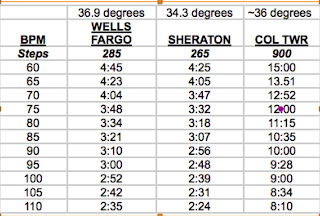 |
| Roy Davis (Standing Left) at Stairclimbing Awards Ceremony |
Climbing stairs for fun, competition or a working fire can be reduced to a simple linear equation where the variables are angle of attack (in degrees), number of steps and riser height. The rate of work is dependent upon your aerobic capacity. The caveat is that the principle of specificity of kicks in; meaning that fitness is specific to the activity and you need to practice, or train doing the exercise.
Adding a shoulder load increases the energy cost proportionate to the percentage of your body weight. Climbing (lifting your body weight) is the most arduous of all physical activities. The only thing more difficult is climbing a rope using only your arms- now that hard work.
Roy Davis, retired Firefighter Combat Challenge Champion has engaged in a number of stair climb events and has created a matrix that’s helpful in creating a number of targets (i.e., number of double stairs in a set period of time). This is the same way that one would train for running a mile by calculating the splits for each quarter.
Table 1: Stair Climbing Rates
The key is that you must work within your capabilities; actually slightly below that point where you start to produce more lactate than you can turnover. Otherwise, everything comes to a screeching halt.
I noticed in Seattle that a number of firefighters had calculated the splits by floors and reduced them to a laminated “cheat sheet” much like the way quarterbacks list the plays on their wrists. Other’s had put a playlist together with a cadence consistent with their climbing objective of a specific number of steps per minute. This was done by using a metronome or a software program (Mixmeister.com) that will find songs with a cadence consistent with the targeted rate of climb.
By finding a stairway in which to practice you can rest assured that your first stair climb for record will be a success. Like any aerobic fitness event, you can expect improvements of about 1% per week. Since leg strength enters the equation with added weight, improvements might come faster.
Keep in mind that the thermal load of climbing can be significant- more than 15kcal/min, so you’ll want to dump heat by opening up your vents! Most of your heat is dissipated through your head. A helmet interferes with this process. If you’re going to be climbing for 25 minutes, heat exhaustion can complicate the effort.
A direct benefit will be the confidence that comes from knowing that if you have to do this for real, you can!


No comments:
Post a Comment